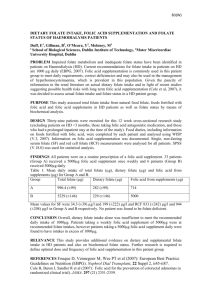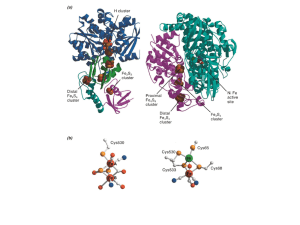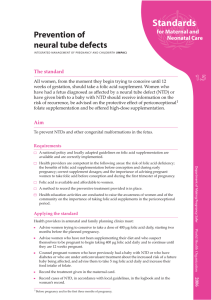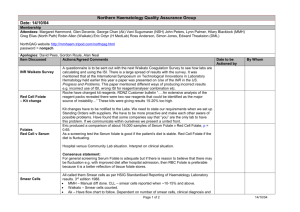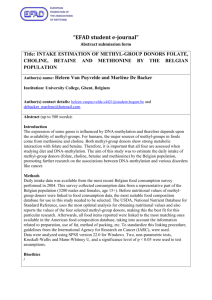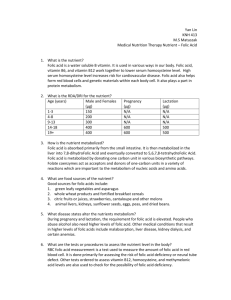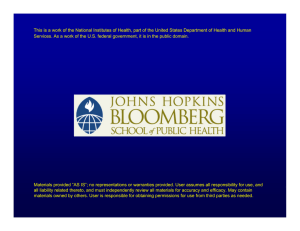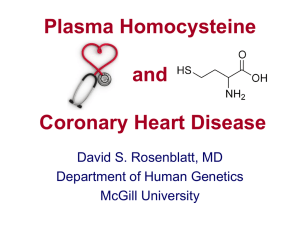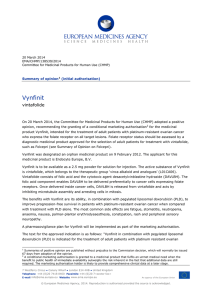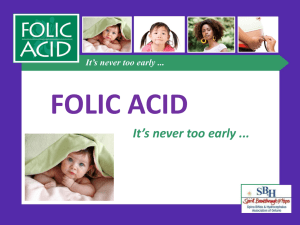Folated - Bangor University
advertisement
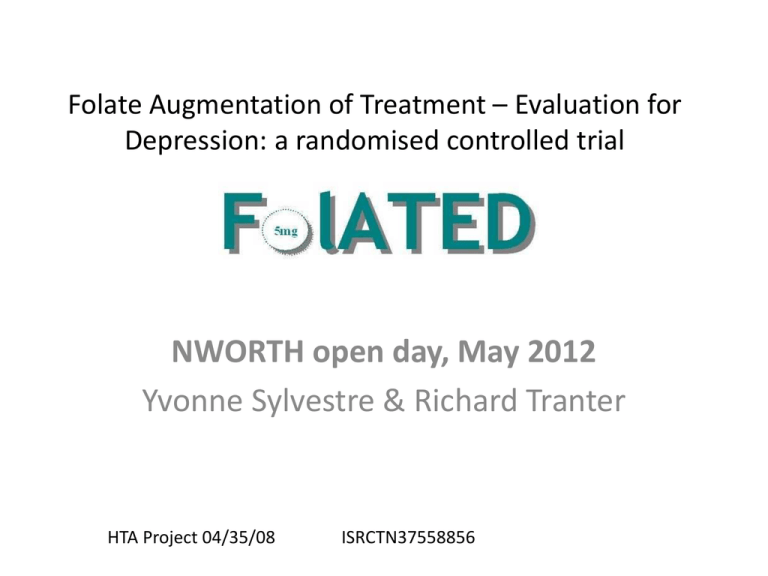
Folate Augmentation of Treatment – Evaluation for Depression: a randomised controlled trial NWORTH open day, May 2012 Yvonne Sylvestre & Richard Tranter HTA Project 04/35/08 ISRCTN37558856 Background Depression • Predicted to be the second leading cause of disability by 2020 1 • 1 in 5 experience depression & only half will respond to antidepressants 2 Folate status in patients with depression • 1/3 of patients with depression have decreased folate levels 3 • Patients with low folate respond less well to antidepressants 4 Folate & antidepressant response • Antidepressants work via effects on synaptic neurotransmitter activity • Folate is a methyl-donor in many methylation reactions in the brain involving these neurotransmitters 5 • Fluoxetine (20mg) & folic acid (10mg) or placebo for 6 weeks. N=27. Clinically significant improvement on HAM-D for the folic acid group compared to placebo. 25 Non-systematic reviews: Augmenting antidepressants with folate 6, 7, 8, 9, 10, 11 Low folate levels and depression 12 L-methylfolate and depression 13 Research questions PRIMARY OBJECTIVE • To estimate the clinical- and cost-effectiveness of folate augmentation in antidepressant treatment of moderate to severe depression. SECONDARY OBJECTIVES To evaluate whether: • response to antidepressants depends on genetic polymorphisms • baseline folate status predicts treatment response • folate augmentation decreases homocysteine levels and increases MethylMalonic Acid levels FolATED is a collaboration between … and is supported by … Overview: Design Screening Interview (Visit 1 week -2) HTA funded £1.5 million Randomisation (Visit 2 week 0) Large, multi-centred, double-blind, placebo-controlled trial Recruited from primary and secondary care from the three centres in Wales (North East Wales, North West Wales and Swansea) Randomised to 5mg folic acid or matching placebo for 12 weeks Blood results Randomisation (Folic acid/placebo) Repeat assessments First follow up (Visit 3 week 4) Second follow up (Visit 4 week 12) Third follow up (Visit 5 month 6) Health economics aims • To assess the cost-effectiveness of folic acid augmentation of antidepressant response • Objectives: – to estimate benefits in terms of quality-adjusted lifeyears – to estimate total costs from the perspective of the NHS and PSS – to estimate the incremental cost utility ratio – to assess decision uncertainty (probability of costeffectiveness) Interpreting health economics findings Incremental Costs Less effective, more costly Dominated £30k/QALY More effective, more costly Incremental QALYs Less effective, less costly More effective, less costly Dominant Metabolism of folate and homocysteine Folic acid DHFR Dietary protein DHF (dietary) DHFR Methionine THF 5,10-Methylene THF FAD MTHFR BHMT MS B12 5-Methyl-THF Remethylation SAM Betaine Homocysteine SAH CH3 B6 CßS Cystathionine Transulphuration Cysteine FOLATED – Biochemistry Protocol • Patients to receive either Placebo or 5mg FA/day for 12 weeks • Plasma Hcy, Folate & B12 to be measured baseline, 12 weeks & 6 months • Sub-study: Low B12 subgroup (< 260ng/L), ↑folate ↔ ↑MMA Genetics Hypothesis • Dan Carr & Andrea Jorgensen, Wolfson Centre for Personalised Medicine University of Liverpool • Variation of one-carbon folate and methionine synthesis pathway genes influences efficacy of folic acid as an adjuvant to antidepressant therapy. • 25 candidate genes selected based on functionality associated with either the one carbon folate or methionine pathways • Are these variants predictive of efficacy? Candidate Gene Selection DIET Thymidylate synthesis THF-polyglutamate Folic Acid 5-methyl-THFpolyglutmate dUMP FPGS dTMP DHFR TYMS FOLH1 5,10methylene-THF FOLR1 DHFR GGH FPGS B6 GART 5,10-methenylTHF B2 THFglutamate SHMT MTHFD1 MTHFR SLC19A1 DHF FTCD 5-formiminoTHF AMT MTHFS 5-formyl-THF 5-methylTHF THF FTCD FTCD MTHFD1 MTHFD1 10-formyl-THF GART Purine synthesis MTRR Homocysteine MTR B12 Betaine Methionine Glycine AHCY Cysteine CTH ATIC TCN2 BHMT Serine CBS ALDH1L1 MTFMT MAT1A S-adenosyl homocysteine DNMT1 S-adenosyl methionine AMD1 Cystathione DNA Methylation S-adenosyl methionineamine Carr DF, et al. 2009. Pharmacogenomics J. Oct;9(5):291-305. Consort pre randomisation Referred 1488 Screened 863 Consented 636 Randomised 475 Consort post randomisation 475 Randomised Group A 237 Group B 238 Lost to follow up 14 Lost to follow up 21 223 217 Who participated? 280 women 64% 160 men 36% Aged between 19 and 81 years (mean 45) Recruitment centres Bangor (51%), Wrexham (25%), Swansea (24%) Who participated? 28% in full time work 28% part time work, students or retired 43% unemployed, at home or sick 23% single, 21% previously had partner, 55% currently had a partner or spouse Other sample characteristics • Entry criteria - moderate to severe depression Becks Depression Inventory, BDI > 18 (mean 33.7 s.d. 9.6) • 25% new antidepressant treatment at recruitment, 75% continuing treatment • 19% of men and 12% of women drank at unsafe levels Principles of Analysis • Pre-specified analysis plan written prior to analysis, which evolved to cover challenges in the data • Data reported to CONSORT standards • Primary analysis by “Treatment as Allocated” • Missing data imputed by rigorous algorithm to minimise bias. • Following best practice, we used 2 semi-independent analysis teams. • Statistical and economic analyses techniques aligned Primary Statistical Analysis Step 1:Unadjusted results Step 2:Adjusted analysis Primary and secondary Step 3:Exploratory endpoints analysis on all variables of interest extended over every time-point As for step 1 with the addition of adjustments for stratification covariables and baseline measures A full structured analysis of all significant factors and interactions designed to further explore and explain results from stage 2. Results • Definitive RCT of folic acid augmentation of antidepressant treatment. • Unequivocal results that will inform future treatment guidelines. • 1st draft of report submitted to HTA and awaiting review. But does Folic Acid work? Watch this space ……………………………. The Folated team thanks you for listening.
